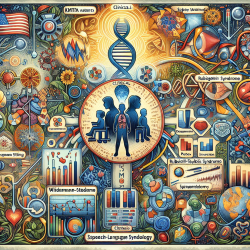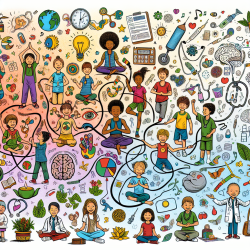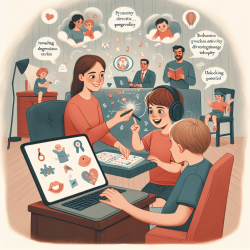Introduction
The recent research article, "Expanding the phenotype associated to KMT2A variants: overlapping clinical signs between Wiedemann–Steiner and Rubinstein–Taybi syndromes," offers valuable insights into the genetic underpinnings and clinical manifestations of these syndromes. As a practitioner in the field of speech-language pathology, understanding these findings can enhance your ability to make data-driven decisions and improve outcomes for children with these conditions.
Key Findings
The study identifies novel KMT2A variants in patients initially diagnosed with Rubinstein–Taybi Syndrome (RSTS) but exhibiting overlapping clinical signs with Wiedemann–Steiner Syndrome (WDSTS). These findings emphasize the interconnected nature of genetic disorders involving the epigenetic machinery, which includes genes responsible for chromatin remodeling and gene expression regulation.
Clinical Implications
Understanding the overlap between RSTS and WDSTS can help practitioners in several ways:
- Improved Diagnosis: Recognizing the shared clinical features can lead to more accurate diagnoses, especially in cases where traditional genetic markers for RSTS (CREBBP and EP300) are absent.
- Targeted Interventions: Knowledge of the specific genetic variants can guide more personalized intervention strategies, potentially improving speech and language outcomes for affected children.
- Comprehensive Assessments: Incorporating genetic screening into your assessment protocols can provide a more holistic understanding of a child's condition, leading to better-informed therapeutic decisions.
Encouraging Further Research
This study underscores the importance of continued research into the genetic and epigenetic mechanisms underlying complex syndromes. Practitioners are encouraged to stay updated on the latest research and consider participating in or supporting studies that aim to uncover new genetic variants and their clinical implications.
Practical Steps for Practitioners
Here are some practical steps you can take to integrate these findings into your practice:
- Stay Informed: Regularly review current research on genetic and epigenetic factors affecting speech and language development.
- Collaborate with Geneticists: Work closely with geneticists to incorporate genetic screening into your diagnostic process, ensuring a comprehensive understanding of each child's condition.
- Educate Families: Provide families with information about the genetic aspects of their child's condition, helping them understand the importance of genetic testing and its potential impact on treatment.
- Advocate for Research: Encourage and support research initiatives aimed at exploring the genetic basis of speech and language disorders, contributing to the broader knowledge base and improving clinical outcomes.
Conclusion
The findings from the study "Expanding the phenotype associated to KMT2A variants: overlapping clinical signs between Wiedemann–Steiner and Rubinstein–Taybi syndromes" highlight the intricate relationship between genetic variants and clinical presentations. By integrating these insights into your practice, you can enhance your diagnostic accuracy, tailor interventions more effectively, and ultimately improve outcomes for children with these complex syndromes.
To read the original research paper, please follow this link: Expanding the phenotype associated to KMT2A variants: overlapping clinical signs between Wiedemann–Steiner and Rubinstein–Taybi syndromes.










